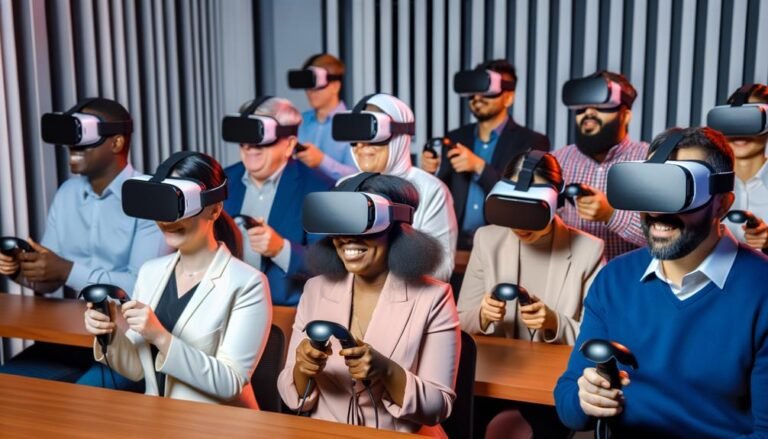Fostering Innovation and Creativity Through Employee Development
In today's rapidly evolving business landscape, organizations are constantly seeking ways to stay ahead of their competitors. One key aspect that can give them a competitive edge is fostering innovation and creativity among their employees.
By investing in employee development, organizations can unlock the untapped potential of their workforce and drive innovation from within.
But how can organizations effectively foster innovation and creativity?
In this discussion, we will explore various strategies and initiatives that can help organizations create a culture of innovation and creativity, ultimately leading to increased productivity and success.
Key Takeaways
- Continuous learning and skill enhancement are essential for fostering innovation and creativity in employees.
- Encouraging a growth mindset is crucial for creating an environment that supports innovation and creativity.
- Cross-functional training can enhance collaboration and innovation by promoting a broader understanding of the business.
- Collaborative learning empowers employees to develop new skills, share insights, and drive innovation and creativity.
Continuous Learning and Skill Enhancement
Continuous learning and skill enhancement are essential for fostering innovation and creativity in the workplace. In today's rapidly changing business landscape, organizations must continuously adapt to stay competitive. This means that employees need to continuously learn new skills and enhance their existing ones to keep up with the evolving demands of their roles.
Continuous learning involves acquiring new knowledge, skills, and competencies throughout one's career. It can be achieved through various means, such as attending training programs, workshops, webinars, or pursuing higher education. By continuously learning, employees can stay updated with the latest industry trends, technologies, and best practices, enabling them to bring fresh ideas and perspectives to their work.
Skill enhancement, on the other hand, focuses on improving existing skills to achieve higher levels of proficiency. This can be done through practice, feedback, and seeking opportunities for growth and development. By continually honing their skills, employees can become more efficient and effective in their roles, leading to improved performance and productivity.
Continuous learning and skill enhancement also contribute to employee engagement and job satisfaction. When employees are given opportunities to learn and grow, they feel valued and supported by their organization. This, in turn, boosts their motivation and commitment to their work, fostering a culture of innovation and creativity.
Encouraging a Growth Mindset
To foster a culture of innovation and creativity, organizations should encourage employees to adopt a growth mindset. A growth mindset is the belief that abilities and intelligence can be developed through dedication and effort. By promoting a growth mindset, organizations can create an environment that fosters creativity and encourages employees to take risks and think outside the box.
Here are four ways organizations can encourage a growth mindset:
- Provide opportunities for learning and growth: Offer training programs, workshops, and conferences that allow employees to develop new skills and expand their knowledge.
- Emphasize the importance of effort and perseverance: Recognize and reward employees who demonstrate a strong work ethic and a willingness to overcome challenges.
- Encourage collaboration and feedback: Create an atmosphere where employees feel comfortable sharing ideas and receiving constructive criticism from their peers.
- Lead by example: Managers and leaders should exhibit a growth mindset themselves and demonstrate a willingness to learn and adapt.
Providing Cross-Functional Training
Providing cross-functional training is essential for skill expansion and fostering collaborative learning within an organization. By offering employees the opportunity to develop expertise in multiple areas, organizations can increase their capacity for innovation and creativity.
Cross-functional training encourages employees to think outside of their silos, promotes a broader understanding of the business, and enhances communication and collaboration across departments.
Skill Expansion
Skill expansion through cross-functional training enhances employee development for innovation and creativity in a professional setting. By providing employees with opportunities to acquire new skills and develop their talents, organizations can foster a culture of continuous learning and growth.
Here are four ways in which skill expansion through cross-functional training can benefit employees and contribute to their development:
- Broadens knowledge and expertise: Cross-functional training allows employees to gain insights and knowledge from different departments or areas of expertise, enabling them to develop a more comprehensive understanding of their organization and its operations.
- Enhances problem-solving abilities: Exposure to different functions and perspectives helps employees develop critical thinking skills and problem-solving abilities, as they learn to approach challenges from different angles.
- Promotes collaboration and teamwork: Cross-functional training encourages collaboration and teamwork, as employees from different departments come together to share ideas, insights, and experiences.
- Boosts adaptability and flexibility: By acquiring new skills and knowledge, employees become more adaptable and flexible, allowing them to navigate changes and challenges with ease.
Collaborative Learning
Collaborative learning is a key strategy for enhancing employee development and fostering innovation and creativity in a professional setting. By engaging employees in collaborative projects, organizations can provide cross-functional training that encourages peer learning and knowledge sharing.
Collaborative learning allows employees from different departments or teams to work together, leveraging their unique skills and perspectives to solve complex problems and generate new ideas. This approach promotes a culture of collaboration and encourages employees to learn from one another, leading to a deeper understanding of various business functions and processes.
Moreover, collaborative learning helps to break down silos within an organization, facilitating the transfer of knowledge and expertise across different areas. By providing opportunities for cross-functional training and fostering collaborative projects, companies can empower their employees to develop new skills, share insights, and drive innovation and creativity in the workplace.
Promoting Collaboration and Teamwork
Promoting collaboration and teamwork is essential for fostering innovation and creativity within an organization.
By encouraging synergy in teamwork, employees can leverage their diverse skills and perspectives to tackle complex problems collectively.
Collaborative brainstorming sessions provide a platform for exchanging ideas and fueling innovation, leading to more effective problem-solving and ultimately driving organizational growth.
Synergy in Teamwork
Effective teamwork requires the seamless integration of individual strengths and expertise towards a common goal. Synergy in teamwork refers to the harmonious collaboration and coordination of team members, resulting in enhanced productivity and innovation. To promote synergy within a team, it is crucial to focus on team dynamics and effective communication.
Here are some key strategies to foster synergy in teamwork:
- Establish clear team goals and objectives to align everyone's efforts.
- Encourage open and transparent communication to foster trust and understanding.
- Foster a collaborative work environment where ideas can be freely shared and discussed.
- Promote diversity and inclusivity within the team to leverage different perspectives and ideas.
Collective Problem-Solving
Collective problem-solving is an essential aspect of fostering collaboration and teamwork within an organization. When a group of individuals come together to solve a problem, they bring their unique perspectives, knowledge, and skills to the table. This diversity of ideas and experiences can lead to more innovative and effective solutions.
One way to promote collective problem-solving is through group problem-solving techniques such as brainstorming, where all team members are encouraged to contribute their ideas without judgment. Another effective approach is using collective decision-making processes, where the group discusses and evaluates different options before reaching a consensus.
To visually illustrate the benefits of collective problem-solving, consider the following table:
| Individual Problem-Solving | Collective Problem-Solving |
|---|---|
| Limited perspectives | Diverse perspectives |
| Limited creativity | Enhanced creativity |
| Limited problem-solving skills | Combined problem-solving skills |
| Potential for bias | Balanced decision-making |
Collaborative Brainstorming Sessions
Collaborative brainstorming sessions facilitate the exchange of diverse ideas and foster teamwork within an organization. These sessions provide a platform for employees to come together and collectively generate innovative solutions to problems or ideas for new projects.
By encouraging open communication and allowing all participants to contribute their thoughts and perspectives, collaborative brainstorming creates a sense of inclusivity and ownership among team members.
To make these sessions more effective, organizations can incorporate various brainstorming techniques such as mind mapping, random word association, or role-playing. These techniques help stimulate creativity and encourage out-of-the-box thinking.
Additionally, setting clear objectives, providing a supportive environment, and allowing for free-flowing idea generation are crucial in maximizing the potential of collaborative brainstorming sessions.
Such sessions can ultimately lead to breakthrough ideas, improved problem-solving, and a stronger sense of camaraderie among team members.
Offering Mentoring and Coaching Programs
Organizations can enhance employee development by implementing mentoring and coaching programs. These programs have proven to be effective in fostering innovation and creativity within the workforce. Mentoring effectiveness lies in the guidance and support provided by experienced professionals, while coaching benefits employees by helping them develop specific skills and achieve their goals.
Mentoring programs offer a structured approach to learning and growth. Mentors provide valuable insights, advice, and feedback based on their own experiences. This helps mentees gain new perspectives, expand their knowledge, and develop critical thinking skills. Mentoring relationships also create a sense of belonging and support, which boosts employee engagement and job satisfaction.
Coaching programs, on the other hand, focus on the development of specific skills and competencies. Coaches work closely with employees, providing personalized guidance and feedback to help them improve performance and achieve their goals. Coaching programs have been found to enhance employee motivation, productivity, and self-confidence, leading to higher levels of innovation and creativity.
To illustrate the benefits of mentoring and coaching programs, the following table highlights their key characteristics:
| Mentoring Programs | Coaching Programs |
|---|---|
| Guided by experienced professionals | Focused on skill development |
| Provides guidance, advice, and feedback | Offers personalized coaching |
| Enhances critical thinking skills | Improves performance and productivity |
| Fosters a sense of belonging and support | Boosts employee motivation and self-confidence |
Embracing Diversity and Inclusion
Embracing diversity and inclusion is crucial for fostering innovation and creativity in the workplace.
Cultural awareness allows employees to gain a deeper understanding and appreciation for different perspectives, leading to more diverse and well-rounded ideas.
Equal opportunity ensures that all individuals have the chance to contribute their unique skills and experiences, creating a collaborative environment where innovation can thrive.
Cultural Awareness
Cultivating an inclusive work environment that values diversity is crucial for fostering employee development in innovation and creativity. Cultural awareness plays a significant role in embracing diversity and inclusion.
To promote cultural sensitivity and intercultural communication, organizations can implement the following strategies:
- Training programs: Provide employees with workshops and training sessions that focus on cultural sensitivity, helping them understand and appreciate different cultural perspectives.
- Employee resource groups: Encourage the formation of employee resource groups that celebrate diverse cultures and provide a platform for open discussions on cultural issues.
- Mentorship programs: Pair employees from different cultural backgrounds to foster mutual learning and understanding.
- Language and communication support: Offer resources and tools that facilitate effective communication across cultural barriers, such as translation services or language training.
Equal Opportunity
Promoting equal opportunity and embracing diversity and inclusion are essential for fostering employee development in innovation and creativity. By providing equal opportunities for all employees, regardless of their background or characteristics, organizations can tap into a diverse pool of talent and perspectives. This not only encourages a sense of belonging and inclusivity but also creates an environment where employees feel valued and motivated to contribute their unique ideas and experiences. Cultural awareness plays a significant role in promoting equal opportunity by recognizing and valuing different cultural backgrounds and perspectives. By embracing diversity and inclusion, organizations can unlock the full potential of their workforce, leading to enhanced innovation, creativity, and overall business success.
| Column 1 | Column 2 | Column 3 |
|---|---|---|
| Diversity in perspectives | Increased innovation | Enhanced problem-solving |
| Inclusion and belonging | Creativity and out-of-the-box thinking | Improved decision-making |
| Equal opportunity | Collaboration and teamwork | Higher employee engagement |
Collaborative Environments
Creating a collaborative environment that embraces diversity and inclusion is crucial for fostering employee development in innovation and creativity. When employees from diverse backgrounds and with different perspectives come together to work on collaborative projects, they bring a wealth of knowledge and ideas to the table.
This diversity leads to a more comprehensive understanding of problems and solutions, ultimately driving innovation. Additionally, a collaborative environment promotes effective team dynamics, allowing individuals to learn from one another and leverage their unique strengths. It encourages open communication, trust, and respect, creating a space where employees feel comfortable sharing their ideas and challenging the status quo.
Creating a Supportive and Nurturing Environment
A conducive workplace atmosphere that fosters collaboration and encourages open communication is essential for nurturing employee development and fostering innovation and creativity. Creating a supportive and nurturing environment involves the presence of supportive leadership, which plays a crucial role in empowering employees to be more creative and innovative in their work.
Supportive leadership involves providing employees with the necessary resources, guidance, and feedback to enhance their skills and abilities. It requires leaders to create an environment where employees feel valued, respected, and encouraged to take risks and explore new ideas. By demonstrating a genuine interest in their employees' development and success, leaders can inspire trust and foster a sense of psychological safety that allows for the free expression of ideas.
Moreover, fostering creativity requires leaders to create a culture that embraces experimentation and learning from failure. This involves encouraging employees to think outside the box, challenging traditional norms, and being open to new perspectives. By promoting a culture of continuous learning and growth, leaders can create an environment that fuels creativity and innovation.
Allowing Time for Creative Exploration
To foster innovation and creativity, it is crucial for organizations to allocate dedicated time for employees to explore and experiment with new ideas. Allowing time for creative exploration not only encourages employees to think outside the box but also provides them with an opportunity to engage in creative experimentation and innovative thinking.
Here are some key benefits of allocating time for creative exploration:
- Encourages risk-taking: By providing employees with dedicated time for creative exploration, organizations create an environment where employees feel safe to take risks and try out new ideas without fear of failure or negative consequences.
- Sparks innovation: Allowing employees to explore and experiment with new ideas enables them to discover innovative solutions to existing problems or come up with entirely new concepts that can drive the organization forward.
- Enhances problem-solving skills: Creative exploration allows employees to think critically and develop effective problem-solving skills. It encourages them to approach challenges from different angles and find unique solutions.
- Boosts morale and engagement: Giving employees the freedom to explore their creativity and experiment with new ideas shows that their contributions are valued. This, in turn, boosts morale, increases job satisfaction, and enhances overall employee engagement.
Recognizing and Rewarding Innovative Ideas
In order to foster a culture of innovation and creativity, it is essential for organizations to establish effective recognition and reward systems for innovative ideas. Recognizing and rewarding employees' innovative ideas not only motivates them to continue generating new and creative solutions but also reinforces the importance of innovation within the organization.
One way to recognize innovation is through public acknowledgement. Managers can publicly praise and acknowledge employees who come up with innovative ideas, either through company-wide meetings, newsletters, or internal communication channels. This not only provides recognition for the individual but also serves as a source of inspiration for others to contribute their ideas.
Another effective method is to offer tangible rewards or incentives. These can include monetary bonuses, promotions, or special recognition awards. By tying rewards to innovative ideas, organizations encourage employees to actively seek out opportunities for improvement and provide them with a sense of achievement when their ideas are implemented.
To ensure fairness and transparency in the recognition and reward process, organizations can establish a structured evaluation system. This system can involve a committee or panel that reviews and assesses the innovative ideas based on predetermined criteria such as impact, feasibility, and originality. This approach ensures that recognition and rewards are given based on merit and encourages employees to think critically about their ideas before submitting them.
Implementing Feedback Mechanisms for Improvement
Establishing effective feedback mechanisms is crucial for organizations to continuously improve and enhance their innovative ideas and initiatives. Feedback mechanisms provide valuable insights into an employee's performance and help identify areas for improvement. They enable organizations to evaluate the effectiveness of their strategies and make necessary adjustments to drive innovation and creativity.
Here are four ways organizations can implement feedback mechanisms for improvement:
- Regular performance evaluations: Conducting regular performance evaluations allows organizations to provide constructive feedback to employees. These evaluations help identify strengths, weaknesses, and areas that need improvement, fostering a culture of continuous learning and growth.
- 360-degree feedback: Implementing 360-degree feedback allows employees to receive feedback from multiple sources, including peers, supervisors, and even customers. This comprehensive feedback provides a holistic view of an employee's performance and helps identify blind spots and areas for development.
- Real-time feedback: Providing real-time feedback allows employees to make immediate adjustments and improvements. It promotes agility and responsiveness, enabling employees to enhance their innovative ideas and initiatives on the go.
- Anonymous feedback channels: Creating anonymous feedback channels encourages employees to provide honest and constructive feedback without fear of repercussions. This helps organizations gather valuable insights and suggestions for improvement, leading to enhanced innovation and creativity.
Conclusion
In conclusion, fostering innovation and creativity through employee development requires a multifaceted approach. Continuous learning, a growth mindset, and cross-functional training are key components. These initiatives help employees expand their knowledge and skills, allowing them to think outside the box and come up with new ideas. Collaboration and mentoring programs also play a vital role in fostering innovation. By working together and sharing knowledge, employees can leverage each other's strengths and come up with innovative solutions.
Creating a supportive environment is crucial for fostering innovation. It is important for employees to feel safe to take risks and think creatively without fear of judgement or failure. Organizations can achieve this by encouraging open communication, valuing diverse perspectives, and promoting a culture of experimentation.
Allowing time for creative exploration is another important aspect. By dedicating specific time for employees to work on their own projects or explore new ideas, organizations can foster a sense of autonomy and empower employees to think creatively.
Recognizing and rewarding innovative ideas is also important. When employees are acknowledged and appreciated for their contributions, it motivates them to continue thinking creatively and coming up with new solutions. Implementing feedback mechanisms is equally important. By providing employees with constructive feedback and opportunities for improvement, organizations can help them refine their ideas and make them even better.
By embracing these strategies, organizations can create an environment that nurtures creativity and empowers employees to contribute their best ideas and solutions. Through these efforts, organizations can stay ahead in today's rapidly changing business landscape.







